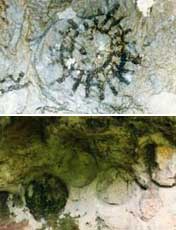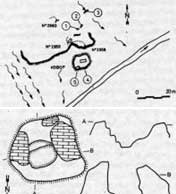T
he
Village of Bailovo

The
rock-cut monument (sanctuary) near the village of Bailovo is created
in a small travertine massif, containing four caves with numbers
from 2958 to 2961 in the main card-index of the Bulgarian caves,
situated along the valley of Smolska river. Caves are known to the
local people as Kalugerski or Monastery caves and are situated at
5 i?? 15m height above the local erosion basis. Specific signs made
in the soft rock have been discovered on the walls of two of them.
The cave with number 2958 is shaped in the form of parallelepiped
after processing, opened to the south. It is visually connected
with an artificial observational ground at the highest point of
the travertine massif (Fig. 1). The ground is carved into the rock.
There are two trenches with a trapezium cross-section at the opposing
edges of the ground, oriented in the plane of the main celestial
meridian in north-south direction. The openings of the caves are
oriented to the South and the same in form and shape carved into
the rock signs have been found (Fig. 2). Because of the similarity
of the images depicting different phases of the Moon they have been
named as Lunar just in the beginning of the exploration.
Two hundred and forty images have been registered at the rock-cut
monument and 126 of them are outlined, 37 are carved into the rock,
and 77 are bas-relief. Their dimensions are different and the diameters
are in the range of 24 i?? 88cm. In several consecutive publications
[1, 2, 3] we give enough proofs that the closed semicircles (19%
from the whole number of images) made with the three kinds of carving
are images of the Moon in different phases (Fig. 3). Comparative
table of the images on the cliffs shows very good coincidence with
the natural lunar phases on the celestial sphere (Fig. 4). Additionally,
it has ben found that the per cent correlations of the signs of
different phases towards the common number of images at the sanctuary
are proportional to the visible lunar phases during the dark part
of the twenty-four hours, juxtaposed for an interval of one synodic
month

Most of the elements of the rock-cut monument near the village of
Bailovo coincide with the basic characteristics of these monuments,
systematized by us in [4]. This monument could be assigned to rocky
sanctuaries honored in a large region, continuously functioning,
and lien remote from larger settlements. The systematic observations
of the Moon were kept by images on the rock, which were also for
worship. Something more, the consecutive changes of the lunar disk
are connected in groups of signs i?? engraved registrations of determined
time intervals. The read notes show periods connected with different
climatic seasons, vegetation cycles, and time between different
cult festivals etc. [5]. Thus, we can make the conclusion that notes
of long time periods made after systematic and purposeful observations
of the visible motion of the Moon and its phases have been carried
out for a long period of time. Most probably, the minimal chronological
boundaries of existence are in the period of 350 years. The usage
of three kinds of execution most probably shows the presence of
three kinds of synchronously denoted records with different semantics.
Even though records could be connected with economic, cult and religious
activity, or with registration of socially significant events, their
reading today is almost impossible because of the lack of signs
for the initial and final epoch of recording.